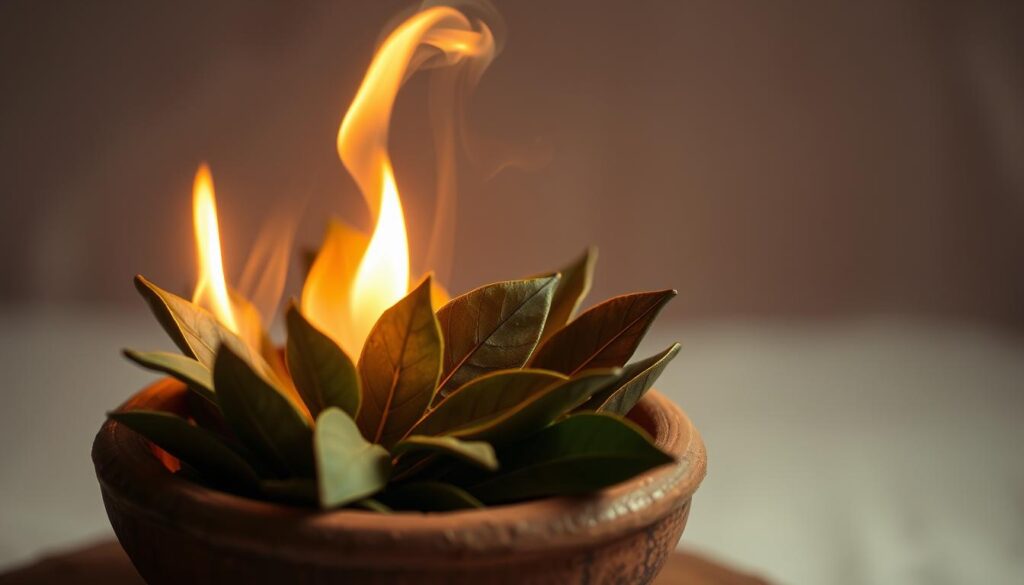The Benefits of Burning Bay Leaves: Laurus nobilis sits in many American kitchens as a simple spice used to flavor soups, stews, and sauces.
Add a whole leaf while simmering, then remove it before serving. That practical habit keeps texture pleasant and flavor clear.
Interest in leaf aroma and rituals goes back centuries, yet modern study work mostly comes from lab and animal research. Early trials suggest effects on blood sugar, wound care, memory in rodents exposed to incense, and mild antimicrobial action, but strong human trials are missing.
Safety first: avoid ingesting essential oil, and be cautious if pregnant, nursing, managing blood sugar, or planning surgery. Stop medicinal use two weeks before an operation.
This article gives a concise, science-minded look at claimed healing uses, safe how-to tips, scent science, kitchen alternatives, and the cultural history behind this laurel.
Key Takeaways
- Laurus nobilis is the true leaf discussed, often Turkish or Californian varieties.
- Most supportive data comes from lab or animal studies, not robust human trials.
- Practical culinary use means adding and then removing the whole leaf during cooking.
- Exercise safety: No essential oil ingestion should be avoided during pregnancy and before surgery.
- The article balances tradition with current research and U.S.-focused guidance.
Quick take: benefits at a glance and what science actually says
Many cultures used laurel smoke for cleansing and calming long before modern labs examined its chemistry. Traditional practice credits incense like ritual with relaxation, space clearing, and protective symbolism.

Modern research is at an early stage. Analyses of Laurus nobilis show volatile compounds such as linalool, cineole, 1,8-cineol, and eugenol. These aroma compounds link to calming scents and possible antimicrobial or anti-inflammatory action in lab tests.
Limited preclinical studies report promising effects: a 2021 rodent study found incense exposure eased memory loss in amnesic rats, and a 2024 mouse study showed oil reduced oxidative brain damage. These are not human-proof results.
You may like to read: How Gut Microbes Influence Mental Well Being
Quick comparison
| Claim | Traditional view | Research status |
|---|---|---|
| Relaxation | Ritual, scent led | Likely aroma driven, plausible |
| Cognitive effects | Historic lore | Animal studies only |
| Antimicrobial action | Purifying smoke | Lab evidence human data limited |
- Perceived benefits often stem from ritual and scent, not reliable systemic dosing.
- Smoke can irritate sensitive people in ventilated spaces.
- Ongoing studies guide ideas but do not equal medical advice.
What are the benefits of burning bay leaves?
A brief smolder of laurel often serves as a quiet cue to pause, breathe, and reset attention.
Relaxation and sleep support: The aroma of laurus nobilis contains linalool, a compound linked in animal work to calming responses. Many people report lower anxiety and easier sleep onset after short, aromatic sessions.
Mental clarity: Rodent studies that exposed animals to incense or oil showed improved cognitive markers. These results hint at possible focus effects, but human evidence remains limited.

Air and antimicrobial notes: Lab tests find antimicrobial properties in extracts and oils, yet indoor smoke is not a proven purifier. Any perceived freshness often comes from scent change, not filtration.
When to avoid smoke: People with asthma, COPD, allergies, or smoke sensitivity should skip leaf burning. Ventilate rooms, keep sessions short, and never inhale essential oil directly.
Treat leaf burning as a soothing ritual, not a medical therapy notice personal effects and prioritize safety.
| Claim | Evidence | Practical note |
|---|---|---|
| Relaxation/sleep | Animal studies linked linalool | Short sessions, ventilate |
| Cognitive focus | Rodent and mouse tests | Promising but not proven in people |
| Air refreshing | Extracts show antimicrobial action in labs | Smoke ≠ air cleaning uses ventilation |
- Traditional energy cleansing rituals work well as mindfulness cues.
- Wound healing is cited in lab studies, but burning a leaf does not replace topical treatment.
- Never ingest whole leaf or apply undiluted essential oil to skin.
How to burn bay leaves safely for maximum effect
Careful preparation and simple safety steps help you enjoy the aroma while limiting indoor smoke and risk.
Choosing quality leaves and fire-safe tools
Select whole, dry Laurus nobilis leaves that show no mold. Store them in a sealed jar away from humidity to keep the scent reliable.
Use a heat-safe dish, a ceramic bowl, a metal tray, or an abalone shell with sand and clear flammable items within a few feet.
Step by step: light smolder and ventilate
Light one tip, allow a quick flame, then gently blow it out so the leaf smolders. Place the ember in your dish.

Keep a window cracked and waft smoke carefully. Limit sessions to a few minutes in a ventilated room to manage particulate levels.
Frequency, duration, and pairing
Many users find once or twice weekly gives the desired ritual without excess indoor smoke. For more complex scents, pair a small bay piece with a pinch of sage or lavender.
Essential oil vs. whole leaf: what to use and what to avoid
Choose oil in a diffuser if you need scent without smoke. Use just one diluted drop in a water diffuser and never ingest or apply undiluted essential oil to skin.
Avoid burning when anyone in the home has asthma, COPD, or strong allergies. Always keep water nearby and never leave a smoldering leaf unattended.
Treat this practice as a short, mindful ritual prioritize ventilation, proper tools, and minimal exposure.
- Choose clean Laurus nobilis leaves, store dry.
- Use a fireproof dish and keep water at hand.
- Light, smolder, ventilate limit sessions and pair sparingly.
- Use diffuser oil for a free aroma, following dilution rules.
You may like to read: Why Healthy Eating Matters Beyond Weight Loss
The science behind the scent: potential health benefits and limits
Scientific tests have probed laurel scent and extracts, revealing hints rather than firm conclusions. Ethnopharmacology reviews link traditional use to reduced anxiety and sleep help, while modern work isolates active aroma molecules such as linalool.
Stress and anxiety: ethnopharmacology insights and linalool evidence
Linalool-rich inhalation shows anxiolytic-like responses in mice. These animal findings align with historic calming uses, but human trials are needed to confirm clinical effects.
Cognition and memory: incense exposure in rats and oil in mice
A 2021 study reported that incense exposure improved scopolamine-induced memory loss and oxidative markers in rats. A 2024 mouse study found Laurus nobilis oil reduced oxidative brain damage. Both are promising, but the used doses and delivery methods are unlike casual home scenting.
Antimicrobial and anti-inflammatory properties: what lab studies suggest
Lab assays show antimicrobial and anti-inflammatory action in extracts and oil. Antioxidant activity appears in test tube work, and wound healing is limited to animals and combined lab models.
Treat aroma use as a complementary practice, not a substitute for proven medical care.
- Limitations: small samples, animal models, and nonstandard exposure protocols.
- Practical note: prefer diffusion of diluted oil over smoke to test personal response for stress or sleep.
- Conclusion: findings suggest potential, not established, health outcomes.
Beyond burning: culinary and aromatic uses of bay laurel
In kitchens across the U.S., laurel adds depth to slow-cooked pots without demanding attention. It pairs well with common aromatics and helps round out savory profiles in many food preparations.
Flavoring soups, stews, and sauces, why do we remove the leaf
Classic use: Simmer one or two bay leaves in dishes like beans, braises, and tomato sauces to boost flavor, then remove before serving. The whole leaf stays stiff and can be bitter if chewed, so removal is standard practice.
Antioxidant vitamins, and non-smoking use
Fresh laurus nobilis contains vitamins A and C, though dried leaf contributes aroma more than nutrients. Lab reviews link antioxidant and antimicrobial properties mainly to extracts and oils, not a single leaf in a stew.
- Use one or two leaves while cooking, take them out before plating.
- Pair with onion, garlic, and thyme for balanced spice layering.
- For a free scent, simmer a pot with a leaf, citrus peel, and a cinnamon stick.
- Store leaves in an airtight jar, away from heat and light, for up to a year.
| Use | Typical dishes | Notes |
|---|---|---|
| Flavoring | Soups, stews, tomato sauces | Simmer, then remove, adds warmth without overpowering |
| Nutrient content | Fresh vs dried | Fresh has A and C dried, mainly adds aroma |
| Varieties | Turkish, Californian | Turkish milder Californian stronger adjust count |
Treat culinary use as a seasoning technique: aromatic support, modest nutrition, and careful removal for safety.
History and symbolism: from ancient laurel crowns to modern rituals
For millennia, laurel held a special place in ritual, woven into crowns that honored winners and linked people to Apollo.
Households sometimes hung bay laurel sprigs as talismans. Ceremonial incense and small-scale leaf burning featured in purification and divination practices across the Mediterranean and beyond.
Traditional healers used Laurus nobilis for digestion, breathing complaints, and inflammation. These uses predate modern pharmacology but match the plant’s aromatic, antimicrobial profile.
Today, bay leaf burning often plays a symbolic role in mindfulness and space-clearing rituals. Users report that scent and ritual help set intention, calm breathing, and support reflective moments rather than replace medical care.
- From wreaths to wellness: laurel moved from public honor to personal ritual.
- Incense and intent: smoke tied ceremony to purification and insight.
- Respectful use: honor historical context, confirm plant identity Laurus nobilis, and prioritize safety.
Symbol and scent work together appreciate tradition, but keep practice safe and personal.
Conclusion
To close: aromatic practice can calm a room and cue mindful breathing, offering a simple pause for body-mind balance.
Evidence to date shows most claimed benefits come from tradition and preliminary studies. Lab and animal work, including a 2021 study, suggest oil extracts may have antimicrobial, antioxidant, or cognitive effects, but human research is limited.
Prioritize safety: limit smoke, ventilate well, and avoid burning if anyone has respiratory sensitivity. Never ingest essential oils and keep dilution and use caution.
For lower exposure, diffuse one drop of bay oil or make a simmer pot with a bay leaf and citrus. Culinary use remains the best-established way to enjoy bay leaves in daily cooking.
Bottom line: Use scent and ritual as a modest wellness tool. If aroma eases stress or anxiety, apply it moderately and responsibly within a broader healthy routine.
You may like to read: 7 Drinks to Burn Belly Fat





